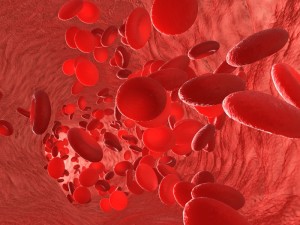Do migraine sufferers have weakened blood vessels?
People with migraines have an increased risk of stroke and cardiovascular disease. But impaired blood vessel function outside the brain is probably not the cause.
MIGRAINE: Researchers at NTNU collected headache and endothelial function data from 3929 healthy adults who participated in the third Nord-Trøndelag Health Study (HUNT3).

Endothelium helps to ensure that the blood vessels relax and can expand to increase blood flow when we do physically demanding work. Illustration: Thinkstock
The endothelium is the innermost cell layer in the blood vessel wall, and thus has direct contact with the blood. These cells help ensure that blood vessels relax and can expand to increase blood flow when we do physically demanding work.
Healthy endothelial cells also prevent harmful substances from sticking to the vessel wall, and poor endothelial function is a precursor of cardiovascular disease. Flow-mediated vasodilatation (FMD) is an ultrasound-based measure of the expansion capability of the blood vessels and is used to examine endothelial function.
- You might also like: Botox treats suicide headaches
No connection
Researchers could not find any correlation between the ability that blood vessels in the arm have to expand and migraines with or without aura, tension headaches or other types of headaches.
“The findings suggest that impaired endothelial function in peripheral circulation cannot explain the link between migraines and cardiovascular disease,” says NTNU Professor Knut Hagen in the Department of Neuroscience.

Researchers found no correlation between the ability of blood vessels in the arm to expand and different types of migraine or headache. A link to heart problems must be found elsewhere. Photo: Thinkstock
Joakim Schjølberg Larsen of the same NTNU department is first author of the study.
No effect
48 per cent of the women and 36 per cent of the men reported that they had experienced headaches during the past year. Based on 12 questions about headaches, researchers categorized them as tension headaches, migraines with or without aura, or unclassified headaches.
After adjusting for factors that can be related to both headaches and endothelial function, scientists could not detect impaired blood vessel function measured in the arm in any of the four categories of headaches compared to subjects without headaches. The results were the same for both women and men.
“The mechanisms linking migraine to cardiovascular disease are complex. Since measurements of peripheral blood circulation are not helpful in identifying migraine patients, further mapping of the causality between migraines and cardiovascular disease must focus more on intracranial conditions,” says Hagen.
Reference: Larsen, J. S., Skaug, E. A., Wisløff, U., Ellingsen, Ø., Stovner, L. J., Linde, M., & Hagen, K. (2016). Migraine and endothelial function: The HUNT3 Study. Cephalalgia, 0333102416631961.




